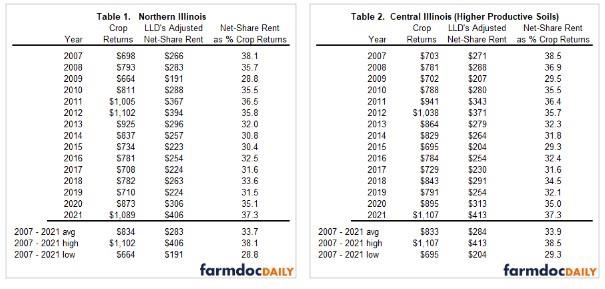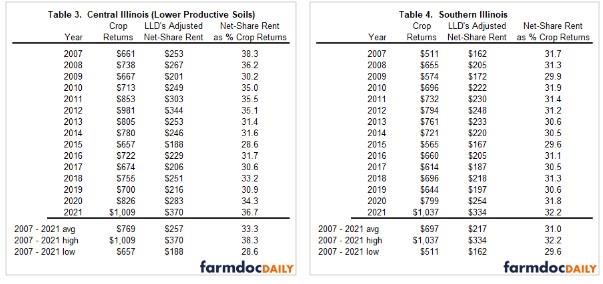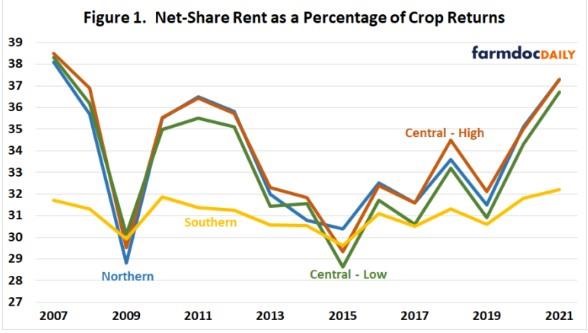By Bradley Zwilling
Illinois FBFM Association and Department of Agricultural and Consumer Economics
University of Illinois
Dale Lattz
Department of Agricultural and Consumer Economics
University of Illinois
Over time, more farmland leases in Illinois have been shifting from traditional crop share leases to cash leases. In addition, there has been some increase in flexible or variable rent cash leases from fixed cash leases. Variable cash rent leases have terms that tie the cash rent amount the operator pays for the year to some measure of the actual economic returns for the year. How the actual cash rent is determined varies from one variable lease to another. One type of variable cash lease bases the rent on a percentage of the actual crop returns for the year.
Crop returns can be calculated in different ways but a common approach is to use actual yields times an average crop price. The average price may be an average price at a local elevator over a certain period that the grain is traditionally marketed. Payments from government farm programs may also be included in crop returns.
One of the factors in this type of lease that needs to be negotiated is what percentage of the crop returns should be used in determining the cash rent amount. Historical studies have concluded that this percentage maybe as low as 15 to 20 percent on lower productive soils to as high as 35 to 37 percent on the highest productive soils. In this article, we use Illinois Farm Business Farm Management (FBFM) record data from 2007 through 2021 to calculate landowner’s adjusted net-share rent and then compare this figure to crop returns to determine what this percentage has been under typical crop share arrangements. It would seem that this information would be useful in negotiating an appropriate percent of crop returns to be paid for cash rent.
It is important to have an understanding of how landowner’s adjusted net-share rent is calculated. Landowner’s adjusted net-share rent is calculated by taking the share of the crop returns the landowner would be receiving under a typical crop share lease for the area and subtracting off the landowner’s share of shared expenses they would be paying under the crop share lease. For example, in a typical 50/50 crop share lease, the landowner would be receiving 50 percent of the crop proceeds and government payments, if any, and paying 50 percent of the crop expenses. Shared crop expenses normally would include fertilizer, seed, chemicals, drying, storage and crop insurance. Note the shared crop expenses do not include certain expenses that the landowner would be paying whether the lease is a crop share or cash lease, namely real estate taxes and possible some insurance.
Tables 1 through 4 below list crop returns and landowner’s adjusted net-share rent on a per acre basis for 2007 through 2021 for four geographic regions in Illinois. The tables also include the net-share rent amount as a percentage of crop returns.


At the bottom of each table are the averages for the 2007 through 2021 along with the high and low figure for the 15-year period. The average net-share rent as a percent of crop returns for the 15-year period are remarkably close for the four regions, 33.7% for northern Illinois, 33.9% for central Illinois with the higher productive soils, 33.3% for central Illinois with the lower productive soils and 31% for southern Illinois. The range between the highest and lowest percent of gross returns was 9.2 to 9.7 percentage points for northern and central Illinois but only 2.6 percentage points for southern Illinois.
It is interesting to note that the highest crop return per acre for three of the four regions was in 2021 (2012 for Northern Illinois) but this was not the highest percent crop returns for three of the four areas. For northern and central Illinois, the highest net-share rent as a percentage of crop returns occurred in 2007. For southern Illinois, it is for 2021. Even though crop returns and landowner’s adjusted net-share rent were higher in 2021 than 2007, the net-share rent figure did not increase at the same rate as crop returns due to higher costs resulting in a lower crop return percentage in 2012 compared to 2021. The lowest net-share rent as a percent of crop returns occurred in 2015 for central and southern Illinois and in 2009 for northern Illinois.

The general observation during the 2007 through 2021 time-period is that this percentage started at it highest level in 2007, decreased and then peaked during the 2010 through 2012 time-period, trended downward through 2015 and has been moving higher through 2021. This has especially been the case for northern and central Illinois. This percentage has been much flatter for southern Illinois.
Projections for 2022 and 2023 indicate that the net-share rent as a percentage of crop returns will decrease compared to 2021. Actual farm data will confirm this or not.
A set percentage of crop returns is the factor that determines the amount of cash rent paid per acre by some variable cash rent leases. Historical and more recent studies indicate for the most productive land in Illinois an appropriate percentage of crop returns would be in the mid to upper thirty percent range. For lower productive soils an appropriate percentage would be in the low thirty or high twenty percent range. This is based on a return to landowners similar to what they would be earning on a “typical” crop share lease for the area. These percentages might be adjusted up or down based on other factors and goals of the landowner and operator. It is also suggested that these percentages should be reviewed from time to time as changes in crop returns and expenses affect returns to farmland.
Source : illinois.edu